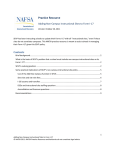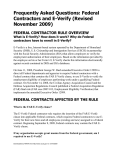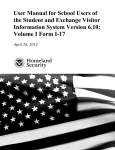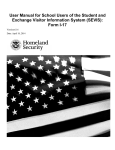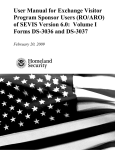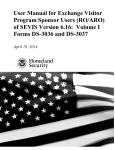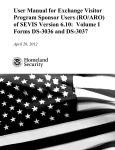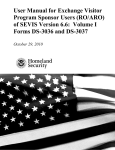Download SEVIS Q&A questions
Transcript
SEVIS Technical and Policy Conference Call April 22, 2009 NAFSA Summary of DHS responses Contents 1. Travel Signature Validity ....................................................................................... 1 2. M-1 Extend Program and OPT .............................................................................. 1 3. Dates on Form I-539 for M-1 extensions ............................................................... 2 4. M-1 extension I-20 notations ................................................................................. 3 5. Flag Removal ........................................................................................................ 3 6. OPT Batch Issues ................................................................................................. 4 NAFSA Note: SEVP has not provided written answers for the following questions yet. Until written answers are available, NAFSA has provided unofficial summaries of SEVP and USCIS verbal responses compiled by NAFSAns on the teleconference as preliminary guidance. However, the answers are subject to change. 1. Travel Signature Validity The April, 2009 SEVP Quarterly newsletter advised students to carry a “Current I-20 with DSO's signature (less than 60 days old from the Educational Institution listed in SEVIS)” while travelling. However, the I-20 states that each signature is valid for one year. For OPT students, 8 C.F.R. § 214.2(f)(13)(ii) states that the student may re-enter with an EAD used in combination with an I-20 “endorsed for reentry by the DSO within the last six months.” Can SEVP confirm that the travel signature is valid as specified on Form I-20 and the regulations? Would it be possible to correct the newsletter? Summary of SEVP Verbal Response: SEVP confirmed that the travel signature is valid as per the I-20 instructions and the regulations. SEVP has removed the reference to 60 days in the April 2009 Newsletter, and apologized for any inconvenience. 2. M-1 Extend Program and OPT We have received reports that in some instances the California Service Center has been requiring M-1 schools to use the Extend Program function in SEVIS to set the Program End Date equal to or greater than the requested OPT End Date. We believe this is incorrect according to the regulations and guidance communicated in the SEVIS RTI User i Manual and prior SEVIS teleconferences (see endnote for background on this issue). 1 Can USCIS and SEVP confirm that the DSO should not extend the program end date to cover the period of requested OPT, and communicate that guidance to the Service Centers? Summary of SEVP and USCIS verbal response: Both SEVP and USCIS confirmed that the DSO should not use the Extend Program function in the context of an M-1 application for practical training. The regulations require M-1 practical training to take place after the program end date, and the program end date should not be extended to cover the period of requested practical training. Clarifying guidance will be communicated to the Service Centers, and be incorporated into the Adjudicator‟s Field Manual now under development. However, the M-1 period of stay as reflected on the I-94 must cover the entire period of OPT; if not, the student must file an I-539 for extension of stay. NAFSA Note: USCIS and SEVP now have a monthly teleconference with representatives from the student lines at all Service Centers to discuss current issues and guidance. 3. Dates on Form I-539 for M-1 extensions The I-539 at Part 3.1. asks: “I/We request that my/our current or requested status be extended until (mm/dd/yyyy):” In the past, M-1 students would put the new Program End Date if requesting an extension of stay under 214.2(m)(10), and the OPT employment end date if requesting an I-94 extension to accommodate a period of OPT. The service center would add the 30-day grace period beyond that date on the I-94 card to acknowledge the full period of stay authorized by 8 CFR 214.2(m)(5). In some recent cases, however, the service center has not been adding the 30-day grace period to the authorized period of stay on the I-94 of M-1 students. Can USCIS and SEVP confirm which date (program/employment end date, or program/employment end date + 30) M-1 students should put in this field when they: o request an extension of stay under 214.2(m)(10) o are filing the I-539 to extend their I-94 to accommodate a period of OPT Summary of USCIS verbal response: The M-1 student should put the new I-20 program end date or the requested practical training end date at this item; the M-1 student should not include the 30 day grace period. The adjudicator will then determine how much grace period time can be given to the student beyond those dates. USCIS will provide clarifying guidance to the Service Centers. If an I-94 card is not properly extended in one of these scenarios, can the student go to the local USCIS office to request a correction of the I-94? 2 NAFSA note: this question was not answered on the call. NAFSA will follow up with USCIS. 4. M-1 extension I-20 notations The SEVIS F/M RTI User Manual states that, "the system prints the requested extended program end date in Field 5 and 'Program Extension Requested' or „Program Extension Pending' in Field 3 (along with 'Continued Attendance at This School') depending on the request status." Advisers have reported, however, that SEVIS does not print an extended end date at Field 5 on Form I-20 until after the Service Center adjudicates the request, and that the extension requested/pending notation appears at the bottom of the I-20 rather than in Field 3. Can USCIS and SEVP advise regarding this discrepancy? Summary of SEVP Verbal Response: SEVP confirmed that the Guidance in the User Manual is correct. The program end date should print in field 5 and the notation should show in field 3. If users notice something else happening in the system, they should contact the SEVIS Help Desk to open a ticket so that the problem may be appropriately tracked down. 5. Flag Removal SEVP has previously allowed DSO/RO to submit a request through the SEVIS Helpdesk or [email protected] for SEVP/CEU to remove a flag for a “non-adverse” termination flag from a student‟s record before the student travels home to avoid unnecessary delays on re-entry. Advisers report that the SEVIS Helpdesk has recently advised that the Helpdesk just received guidance from SEVP that advisers should only request that flags be removed after a student has experienced delays and diversion to secondary inspection on re-entry. One Help Desk officer even indicated that in the future, some flag removal might take place through CBP at the port of entry. Not allowing a DSO/RO to request the removal of a flag before travel will only result in delays and additional work for the student, CBP, CEU and SEVP to resolve when the student tries to re-enter. Can SEVP please confirm that DSO/RO may request the removal of a flag before travel so that the student (and CBP, CEU, and SEVP) do not have any issues upon the student‟s re-entry? Summary of SEVP Verbal Response: SEVP and CEU have instituted a new policy regarding flag removal: flag removal requests should be made only after a student has encountered problems with obtaining visas or reentry. DSOs should not request flag removal as a “pre-emptive step” before a student travels. CEU already has an ongoing process in place to clear most flags relating to non-adverse termination reasons. For example, if a student‟s SEVIS record is terminated for “authorized early withdrawal” and the student leaves the U.S. within the required 15 day period after termination, the flag will be removed from the student‟s SEVIS record. Similarly, if the record is terminated for the reason “change of status approved” and the student has indeed changed status, the flag will be removed. 3 SEVP reports that there are many unnecessary requests for unnecessary flag removals. The Help Desk has reported, for example, opening tickets to clear flags from 100 or more records, many of which do not have flags, or whose flags would have been removed by the CEU in the course of its regular review of such flags. SEVP understands the desire to request removal pre-emptively Note: If the flag was placed long ago and the individual is returning in a status other than the one in which the flag was originally posted, or if the flag is something other than a SEVIS flag, the U.S. Customs and Border Protection Travel Redress Program (TRIP) would be a more appropriate way for an individual to request removal of a flag Deferred from the April 10, 2009 teleconference: 6. OPT Batch Issues Since the SEVIS 6.0 upgrade, the edit OPT employer functionality in batch returns as an error of “S1038: OPT request must be made no later than 60 days after the program end date.” This only happens for those individuals on an APPROVED period of OPT in which the current date is greater than 60 days after the end date on their I-20 program. However, this situation represents the vast majority of post-completion OPTs which will be active after the I-20 program end date. Furthermore, this is an edit that can be done in RTI without any problem and the SEVIS 6.0 functionality was believed to allow a batch edit to accomplish the same functionality. It appears there are rules in place that reject the batching of OPT edit information and this may need to be revised in order to allow true batching of OPT employer information to SEVIS. Summary of SEVP Verbal Response: On May 1, 2009 an emergency release will be implemented to address this issue. i Background on the M-1 Extend Program and OPT issue: The Extend Program function should be used only to request an extension of the academic program under 8 CFR 214.2(m)(10) because “Compelling educational or medical reasons have resulted in a delay to his or her course of study.” Also, under 214.2(m)(14)(i), “Temporary employment for practical training may be authorized only after completion of the student's course of study.” The SEVIS RTI User Manual also indicates at 2.4.5.5.3.5 (Guidelines for Requesting OPT for an M-1 Student) that: “Prior to recommending OPT for an M-1 student, a PDSO or DSO should confirm the following… A P/DSO may request OPT for an M-1 only within 90 days prior to and including the program end date. The OPT start date must be after the program end date.” This question has come up before in SEVIS liaison calls, and SEVP has stated that the Extend Program function should not be used to extend the program end date to coincide with the OPT employment end date: From the Jan 2008 SEVIS Tech & Policy Call: 4 Could you confirm that in the M-1 practical training procedure in SEVIS, the Program End Date should not be changed, i.e., the I-20 issued for M-1 practical training will retain the actual Program End Date, but include an endorsement for practical training beyond that Program End Date. SEVP Response: The program end date should not be changed for practical training on its own. The program end date only needs to be changed when a student also requires an extension of stay. 5





